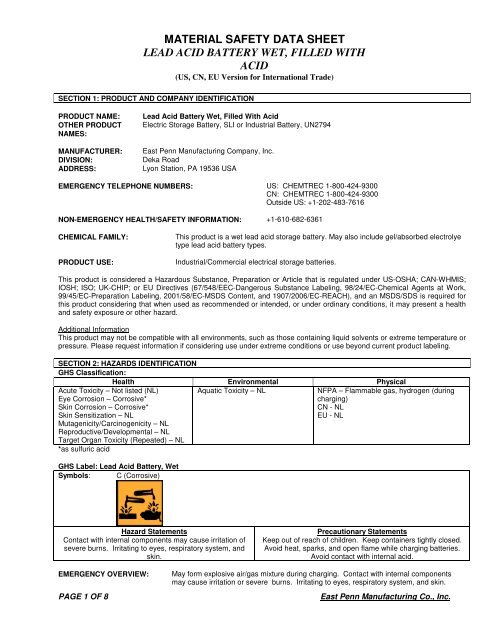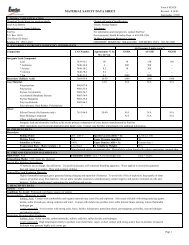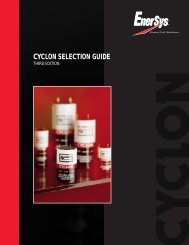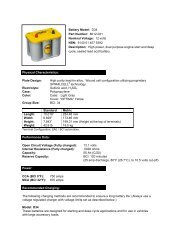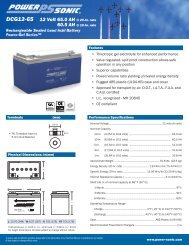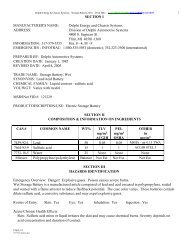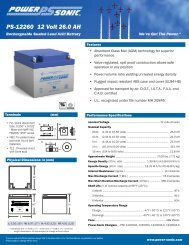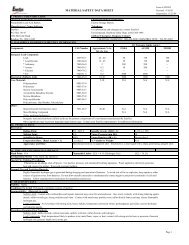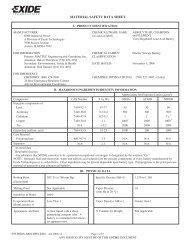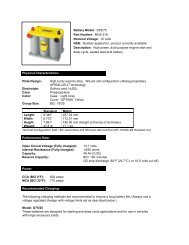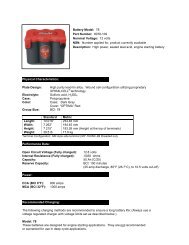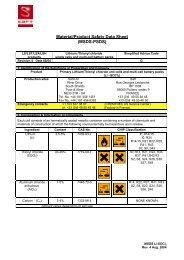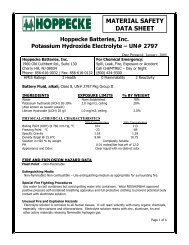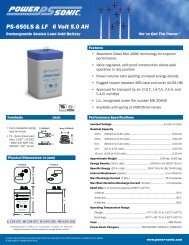Wet Lead Acid MSDS - MK Battery
Wet Lead Acid MSDS - MK Battery
Wet Lead Acid MSDS - MK Battery
You also want an ePaper? Increase the reach of your titles
YUMPU automatically turns print PDFs into web optimized ePapers that Google loves.
MATERIAL SAFETY DATA SHEET<br />
LEAD ACID BATTERY WET, FILLED WITH<br />
ACID<br />
(US, CN, EU Version for International Trade)<br />
SECTION 1: PRODUCT AND COMPANY IDENTIFICATION<br />
PRODUCT NAME:<br />
OTHER PRODUCT<br />
NAMES:<br />
MANUFACTURER:<br />
DIVISION:<br />
ADDRESS:<br />
<strong>Lead</strong> <strong>Acid</strong> <strong>Battery</strong> <strong>Wet</strong>, Filled With <strong>Acid</strong><br />
Electric Storage <strong>Battery</strong>, SLI or Industrial <strong>Battery</strong>, UN2794<br />
East Penn Manufacturing Company, Inc.<br />
Deka Road<br />
Lyon Station, PA 19536 USA<br />
EMERGENCY TELEPHONE NUMBERS: US: CHEMTREC 1-800-424-9300<br />
CN: CHEMTREC 1-800-424-9300<br />
Outside US: +1-202-483-7616<br />
NON-EMERGENCY HEALTH/SAFETY INFORMATION: +1-610-682-6361<br />
CHEMICAL FAMILY:<br />
PRODUCT USE:<br />
This product is a wet lead acid storage battery. May also include gel/absorbed electrolye<br />
type lead acid battery types.<br />
Industrial/Commercial electrical storage batteries.<br />
This product is considered a Hazardous Substance, Preparation or Article that is regulated under US-OSHA; CAN-WHMIS;<br />
IOSH; ISO; UK-CHIP; or EU Directives (67/548/EEC-Dangerous Substance Labeling, 98/24/EC-Chemical Agents at Work,<br />
99/45/EC-Preparation Labeling, 2001/58/EC-<strong>MSDS</strong> Content, and 1907/2006/EC-REACH), and an <strong>MSDS</strong>/SDS is required for<br />
this product considering that when used as recommended or intended, or under ordinary conditions, it may present a health<br />
and safety exposure or other hazard.<br />
Additional Information<br />
This product may not be compatible with all environments, such as those containing liquid solvents or extreme temperature or<br />
pressure. Please request information if considering use under extreme conditions or use beyond current product labeling.<br />
SECTION 2: HAZARDS IDENTIFICATION<br />
GHS Classification:<br />
Health Environmental Physical<br />
Aquatic Toxicity – NL<br />
Acute Toxicity – Not listed (NL)<br />
Eye Corrosion – Corrosive*<br />
Skin Corrosion – Corrosive*<br />
Skin Sensitization – NL<br />
Mutagenicity/Carcinogenicity – NL<br />
Reproductive/Developmental – NL<br />
Target Organ Toxicity (Repeated) – NL<br />
*as sulfuric acid<br />
GHS Label: <strong>Lead</strong> <strong>Acid</strong> <strong>Battery</strong>, <strong>Wet</strong><br />
Symbols: C (Corrosive)<br />
NFPA – Flammable gas, hydrogen (during<br />
charging)<br />
CN - NL<br />
EU - NL<br />
Hazard Statements<br />
Contact with internal components may cause irritation of<br />
severe burns. Irritating to eyes, respiratory system, and<br />
skin.<br />
Precautionary Statements<br />
Keep out of reach of children. Keep containers tightly closed.<br />
Avoid heat, sparks, and open flame while charging batteries.<br />
Avoid contact with internal acid.<br />
EMERGENCY OVERVIEW:<br />
PAGE 1 OF 8<br />
May form explosive air/gas mixture during charging. Contact with internal components<br />
may cause irritation or severe burns. Irritating to eyes, respiratory system, and skin.<br />
East Penn Manufacturing Co., Inc.
MATERIAL SAFETY DATA SHEET<br />
LEAD ACID BATTERY WET, FILLED WITH<br />
ACID<br />
(US, CN, EU Version for International Trade)<br />
Prolonged inhalation or ingestion may result in serious damage to health. Pregnant<br />
women exposed to internal components may experience reproductive/developmental<br />
effects.<br />
POTENTIAL HEALTH EFFECTS:<br />
EYES: Direct contact of internal electrolyte liquid with eyes may cause severe burns or blindness.<br />
SKIN: Direct contact of internal electrolyte liquid with the skin may cause skin irritation or damaging burns.<br />
INGESTION: Swallowing this product may cause severe burns to the esophagus and digestive tract and harmful or<br />
fatal lead poisoning. <strong>Lead</strong> ingestion may cause nausea, vomiting, weight loss, abdominal spasms,<br />
fatigue, and pain in the arms, legs and joints.<br />
INHALATION: Respiratory tract irritation and possible long term effects.<br />
ACUTE HEALTH HAZARDS:<br />
Repeated or prolonged contact may cause mild skin irritation.<br />
CHRONIC HEALTH HAZARDS:<br />
<strong>Lead</strong> poisoning if persons are exposed to internal components of the batteries. <strong>Lead</strong> absorption may cause nausea,<br />
vomiting, weight loss, abdominal spasms, fatigue, pain in the arms, legs and joints. Other effects may include central nervous<br />
system damage, kidney dysfunction, and potential reproductive effects. Chronic inhalation of sulfuric acid mist may increase<br />
the risk of lung cancer.<br />
MEDICAL CONDITIONS GENERALLY AGGRAVATED BY EXPOSURE:<br />
Respiratory and skin diseases may predispose one to acute and chronic effects of sulfuric acid and/or lead. Children and<br />
pregnant women must be protected from lead exposure. Persons with kidney disease may be at increased risk of kidney<br />
failure.<br />
Additional Information<br />
No health effects are expected related to normal use of this product as sold.<br />
SECTION 3: COMPOSITION/INFORMATION ON INGREDIENTS<br />
INGREDIENTS (Chemical/Common Names): CAS No.: % by Wt: EC No.:<br />
<strong>Lead</strong>, inorganic 7439-92-1 43-70 (average: 65) 231-100-4<br />
Sulfuric acid 7664-93-9 20-44 (average: 25) 231-639-5<br />
Antimony 7440-36-0 0-4 (average: 1) 231-146-5<br />
Arsenic 7440-38-2
MATERIAL SAFETY DATA SHEET<br />
LEAD ACID BATTERY WET, FILLED WITH<br />
ACID<br />
(US, CN, EU Version for International Trade)<br />
Dry chemical, carbon dioxide, water, foam. Do not use water on live electrical circuits.<br />
SPECIAL FIRE FIGHTING PROCEDURES & PROTECTIVE EQUIPMENT:<br />
Use appropriate media for surrounding fire. Do not use carbon dioxide directly on cells. Avoid breathing vapors. Use full<br />
protective equipment (bunker gear) and self-contained breathing apparatus.<br />
UNUSUAL FIRE AND EXPLOSION HAZARDS:<br />
Batteries evolve flammable hydrogen gas during charging and may increase fire risk in poorly ventilated areas near sparks,<br />
excessive heat or open flames.<br />
SPECIFIC HAZARDS IN CASE OF FIRE:<br />
Thermal shock may cause battery case to crack open. Containers may explode when heated.<br />
Additional Information<br />
Firefighting water runoff and dilution water may be toxic and corrosive and may cause adverse environmental impacts.<br />
SECTION 6: ACCIDENTAL RELEASE MEASURES<br />
PERSONAL PRECAUTIONS:<br />
Avoid Contact with Skin. Neutralize any spilled electrolyte with neutralizing agents, such as soda ash, sodium bicarbonate, or<br />
very dilute sodium hydroxide solutions.<br />
ENVIRONMENTAL PRECATIONS:<br />
Prevent spilled material from entering sewers and waterways.<br />
SPILL CONTAINMENT & CLEANUP METHODS/MATERIALS:<br />
Add neutralizer/absorbent to spill area. Sweep or shovel spilled material and absorbent and place in approved container.<br />
Dispose of any non-recyclable materials in accordance with local, state, provincial or federal regulations.<br />
Additional Information<br />
<strong>Lead</strong> acid batteries and their plastic cases are recyclable. Contact your East Penn representative for recycling<br />
information.<br />
SECTION 7: HANDLING AND STORAGE<br />
PRECAUTIONS FOR SAFE HANDLING AND STORAGE:<br />
• Keep containers tightly closed when not in use.<br />
• If battery case is broken, avoid contact with internal components.<br />
• Do not handle near heat, sparks, or open flames.<br />
• Protect containers from physical damage to avoid leaks and spills.<br />
• Place cardboard between layers of stacked batteries to avoid damage and short circuits.<br />
• Do not allow conductive material to touch the battery terminals. A dangerous short-circuit may occur and cause battery<br />
failure and fire.<br />
OTHER PRECAUTIONS (e.g.; Incompatibilities):<br />
Keep away from combustible materials, organic chemicals, reducing substances, metals, strong oxidizers and water.<br />
SECTION 8: EXPOSURE CONTROLS/PERSONAL PROTECTION<br />
ENGINEERING CONTROLS/SYSTEM DESIGN INFORMATION:<br />
Charge in areas with adequate ventilation.<br />
VENTILATION:<br />
General dilution ventilation is acceptable.<br />
RESPIRATORY PROTECTION:<br />
Not required for normal conditions of use. See also special firefighting procedures (Section 5).<br />
EYE PROTECTION:<br />
Wear protective glasses with side shields or goggles.<br />
SKIN PROTECTION:<br />
Wear chemical resistant gloves as a standard procedure to prevent skin contact.<br />
OTHER PROTECTIVE CLOTHING OR EQUIPMENT: Chemically-impervious apron and face shield recommended when<br />
adding water or electrolyte to batteries.<br />
Wash Hands after handling.<br />
PAGE 3 OF 8<br />
East Penn Manufacturing Co., Inc.
MATERIAL SAFETY DATA SHEET<br />
LEAD ACID BATTERY WET, FILLED WITH<br />
ACID<br />
(US, CN, EU Version for International Trade)<br />
EXPOSURE GUIDELINES & LIMITS:<br />
OSHA Permissible Exposure Limit (PEL/TWA) <strong>Lead</strong>, inorganic (as Pb) 0.05 mg/m 3<br />
Sulfuric acid 1 mg/m 3<br />
Antimony 0.5 mg/m 3<br />
Arsenic 0.01 mg/m 3<br />
ACGIH 2007 Threshold Limit Value (TLV) <strong>Lead</strong>, inorganic (as Pb) 0.05 mg/m 3<br />
Sulfuric acid 0.2 mg/m 3<br />
Antimony 0.5 mg/m 3<br />
Arsenic 0.01 mg/m 3<br />
Quebec Permissible Exposure Value (PEV) <strong>Lead</strong>, inorganic (as Pb) 0.15 mg/m 3<br />
Sulfuric acid 1 mg/m 3 TWA<br />
3 mg/m 3 STEV<br />
Antimony 0.5 mg/m 3<br />
Arsenic 0.1 mg/m 3<br />
Ontario Occupational Exposure Level (OEL) <strong>Lead</strong> (designated substance) 0.10 mg/m 3<br />
Sulfuric acid 1 mg/m 3 TWAEV<br />
3 mg/m 3 STEV<br />
Antimony 0.5 mg/m 3<br />
Arsenic (designated<br />
0.01 mg/m 3<br />
substance)<br />
Netherlands Maximaal Aanvaarde Concentratie (MAC) <strong>Lead</strong>, inorganic (as Pb) 0.15 mg/m 3<br />
Sulfuric acid 1 mg/m 3<br />
Germany Maximale Arbeitsplatzkonzentrationen (MAK) <strong>Lead</strong>, inorganic (as Pb) 0.1 mg/m 3<br />
Sulfuric acid 1 mg/m 3 TWA<br />
2 mg/m 3 STEL<br />
Antimony 0.5 mg/m 3<br />
United Occupational Exposure Standard (OES) <strong>Lead</strong> 0.15 mg/m 3<br />
Kingdom Antimony 0.5 mg/m 3<br />
Arsenic 0.1 mg/m 3<br />
TWA – 8-Hour Time Weighted Average/ STE – Short Term Exposure / mg/m 3<br />
– milligrams per cubic meter of air/ NE – Not Established<br />
Additional Information<br />
• Batteries are housed in polypropylene cases which are regulated as total dust or respirable dust only when they are<br />
ground up during recycling. The OSHA PEL for dust is 15 mg/m 3 as total dust or 5 mg/m 3 as respirable dust.<br />
• May be required to meet Domestic Requirements for a Specific Destination(s).<br />
SECTION 9: PHYSICAL AND CHEMICAL PROPERTIES<br />
APPEARANCE:<br />
Industrial/commercial lead acid battery<br />
ODOR:<br />
Odorless<br />
ODOR THRESHOLD:<br />
NA<br />
PHYSICAL STATE:<br />
Sulfuric <strong>Acid</strong>: Liquid; <strong>Lead</strong>: solid<br />
pH: 1<br />
SPECIFIC GRAVITY (H2O = 1): 1.27–1.33<br />
EVAPORATION RATE (n-BuAc=1): < 1<br />
SOLUBILITY IN WATER:<br />
100% (as sulfuric acid)<br />
FLASH POINT:<br />
Below room temperature (as hydrogen gas)<br />
AUTO-IGNITION TEMPERATURE: NA<br />
LOWER EXPLOSIVE LIMIT (LEL): 4% (as hydrogen gas)<br />
UPPER EXPLOSIVE LIMIT (UEL): 74% (as hydrogen gas)<br />
PARTITION COEFFICIENT: NA<br />
VISCOSITY (poise @ 25° C): Not Available<br />
PAGE 4 OF 8<br />
East Penn Manufacturing Co., Inc.
MATERIAL SAFETY DATA SHEET<br />
LEAD ACID BATTERY WET, FILLED WITH<br />
ACID<br />
(US, CN, EU Version for International Trade)<br />
DECOMPOSITION TEMPERATURE:<br />
Not Available<br />
FLAMMABILITY/HMIS HAZARD CLASSIFICATIONS (US/CN/EU): As sulfuric acid<br />
HEALTH: 3 FLAMMABILITY: 0 REACTIVITY: 2<br />
SECTION 10: STABILITY AND REACTIVITY<br />
STABILITY:<br />
INCOMPATIBILITY (MATERIAL TO AVOID):<br />
HAZARDOUS DECOMPOSITION BY-<br />
PRODUCTS:<br />
HAZARDOUS POLYMERIZATION:<br />
CONDITIONS TO AVOID:<br />
This product is stable under normal conditions at ambient temperature.<br />
Strong bases, combustible organic materials, reducing agents, finely<br />
divided metals, strong oxidizers, and water.<br />
Thermal decomposition will produce sulfur dioxide, sulfur trioxide,<br />
carbon monoxide, sulfuric acid mist, and hydrogen.<br />
Will not occur<br />
Overcharging, sources of ignition<br />
SECTION 11: TOXICOLOGICAL INFORMATION<br />
ACUTE TOXICITY (Test Results Basis and Comments):<br />
Sulfuric acid: LD 50 , Rat: 21409 mg/kg<br />
LC 50, Guinea pig: 510 mg/m 3<br />
<strong>Lead</strong>: No data available for elemental lead<br />
SUBCHRONIC/CHRONIC TOXICITY (Test Results and Comments):<br />
Repeated exposure to lead and lead compounds in the workplace may result in nervous system toxicity. Some toxicologists<br />
report that abnormal conduction velocities in person with blood lead levels of 50 µg/100 ml or higher. Heavy lead exposure<br />
may result in central nervous system damage, encephalopathy and damage to the blood-forming (hematopoietic) tissues.<br />
Additional Information<br />
• Very little chronic toxicity data available for elemental lead.<br />
• <strong>Lead</strong> is listed by IARC as a 2B carcinogen: possible carcinogen in humans. Arsenic is listed by IARC, ACGIH, and NTP<br />
as a carcinogen, based on studies with high doses overlong periods of time. The other ingredients in this product,<br />
present at equal to or greater than 0.1% of the product, are not listed by OSHA, NTP, or IARC as suspect carcinogens.<br />
• The 19 th Amendment to EC Directive 67/548/EEC classified lead compounds, but not lead in metal form, as possibly toxic<br />
to reproduction. Risk phrase 61: May cause harm to the unborn child, applies to lead compounds, especially soluble<br />
forms.<br />
SECTION 12: ECOLOGICAL INFORMATION<br />
PERSISTENCE & DEGRADABILITY:<br />
<strong>Lead</strong> is very persistent in soils and sediments. No data available on biodegradation.<br />
BIO-ACCUMULATIVE POTENTIAL (Including Mobility):<br />
Mobility of metallic lead between ecological compartments is low. Bioaccumulation of lead occurs in aquatic and terrestrial<br />
animals and plants, but very little bioaccumulation occurs through the food chain. Most studies have included lead<br />
compounds, not solid inorganic lead.<br />
AQUATIC TOXICITY (Test Results & Comments):<br />
Sulfuric acid: 24-hour LC 50, fresh water fish (Brachydanio rerio): 82 mg/l<br />
96-hour LOEC, fresh water fish (Cyprinus carpio): 22 mg/l (lowest observable effect concentration)<br />
<strong>Lead</strong> (metal): No data available<br />
Additional Information<br />
• No known effects on stratospheric ozone depletion.<br />
• Volatile organic compounds: 0% (by Volume)<br />
• Water Endangering Class (WGK): NA<br />
SECTION 13: DISPOSAL CONSIDERATIONS<br />
WASTE DISPOSAL<br />
METHOD:<br />
PAGE 5 OF 8<br />
Follow local, State/Provincial, and Federal/National regulations applicable to as-used, endof-life<br />
characteristics to be determined by end-user.<br />
East Penn Manufacturing Co., Inc.
MATERIAL SAFETY DATA SHEET<br />
LEAD ACID BATTERY WET, FILLED WITH<br />
ACID<br />
(US, CN, EU Version for International Trade)<br />
HAZARDOUS WASTE<br />
CLASS/CODE:<br />
US - Not applicable to finished product as manufactured for distribution into commerce.<br />
CN – Not applicable to finished product as manufactured for distribution into commerce.<br />
EWC – Not applicable to finished product as manufactured for distribution into commerce.<br />
Additional Information<br />
Not Included – Recycle or dispose as allowed by local jurisdiction for the end-of-life characteristics as-disposed.<br />
SECTION 14: TRANSPORT INFORMATION<br />
GROUND – US-DOT/CAN-TDG/EU-ADR/APEC-ADR:<br />
Proper Shipping Name Batteries, <strong>Wet</strong>, Filled with <strong>Acid</strong><br />
Hazard Class 8 ID Number UN2794<br />
Packing Group III Labels Corrosive<br />
AIRCRAFT – ICAO-IATA:<br />
Proper Shipping Name Batteries, <strong>Wet</strong>, Filled with <strong>Acid</strong><br />
Hazard Class 8 ID Number UN2794<br />
Packing Group II Labels Corrosive<br />
Reference IATA packing instructions 800<br />
VESSEL – IMO-IMDG:<br />
Proper Shipping Name Batteries, <strong>Wet</strong>, Filled with <strong>Acid</strong><br />
Hazard Class 8 ID Number UN2794<br />
Packing Group III Labels Corrosive<br />
Reference IMDG packing instructions P801<br />
Additional Information<br />
Transport requires proper packaging and paperwork, including the Nature and Quantity of goods, per applicable<br />
origin/destination/customs points as-shipped.<br />
SECTION 15: REGULATORY INFORMATION<br />
INVENTORY STATUS:<br />
All components are listed on the TSCA; EINECS/ELINCS; and DSL, unless noted otherwise below.<br />
U.S. FEDERAL REGULATIONS:<br />
TSCA Section 8b – Inventory Status: All chemicals comprising this product are either exempt or listed on the TSCA<br />
Inventory.<br />
TSCA Section 12b – Export Notification: If the finished product contains chemicals subject to TSCA Section 12b export<br />
notification, they are listed below:<br />
Chemical CAS #<br />
None<br />
NA<br />
CERCLA (COMPREHENSIVE RESPONSE COMPENSATION, AND LIABILITY ACT)<br />
Chemicals present in the product which could require reporting under the statute:<br />
Chemical CAS #<br />
<strong>Lead</strong> 7439-92-1<br />
Sulfuric acid 7664-93-9<br />
SARA TITLE III (SUPERFUND AMENDMENTS AND REAUTHORIZATION ACT)<br />
The finished product contains chemicals subject to the reporting requirements of Section 313 of SARA Title III.<br />
Chemical CAS # % wt<br />
<strong>Lead</strong> 7439-92-1 65<br />
Sulfuric acid 7664-93-9 25<br />
CERCLA SECTION 311/312 HAZARD CATEGORIES: Note that the finished product is exempt from these regulations,<br />
but lead and sulfuric acid above the thresholds are reportable on Tier II reports.<br />
Fire Hazard<br />
No<br />
Pressure Hazard No<br />
Reactivity Hazard No<br />
Immediate Hazard Yes (Sulfuric acid is Corrosive)<br />
PAGE 6 OF 8<br />
East Penn Manufacturing Co., Inc.
MATERIAL SAFETY DATA SHEET<br />
LEAD ACID BATTERY WET, FILLED WITH<br />
ACID<br />
(US, CN, EU Version for International Trade)<br />
Delayed Hazard No<br />
Note: Sulfuric acid is listed as an Extremely Hazardous Substance.<br />
STATE REGULATIONS (US):<br />
California Proposition 65<br />
The following chemicals identified to exist in the finished product as distributed into commerce are known to the State of<br />
California to cause cancer, birth defects, or other reproductive harm:<br />
Chemical CAS # % Wt<br />
Arsenic (as arsenic oxides) 7440-38-2
MATERIAL SAFETY DATA SHEET<br />
LEAD ACID BATTERY WET, FILLED WITH<br />
ACID<br />
(US, CN, EU Version for International Trade)<br />
control. We make no Warranty of Merchantability, Fitness for any particular purpose or any other Warranty, Expressed or<br />
Implied, with respect to such information and we assume no liability resulting from its use. For this and other reasons, we do<br />
not assume responsibility and expressly disclaim liability for loss, damage or expense arising out of or in any way connected<br />
with the handling, storage, use or disposal of the product. It is the obligation of each user of this product to determine the<br />
suitability of this product and comply with the requirements of all applicable laws regarding use and disposal of this product.<br />
For additional information concerning East Penn Manufacturing Co., Inc. products or questions concerning the content of this<br />
<strong>MSDS</strong> please contact your East Penn representative.<br />
END<br />
PAGE 8 OF 8<br />
East Penn Manufacturing Co., Inc.


